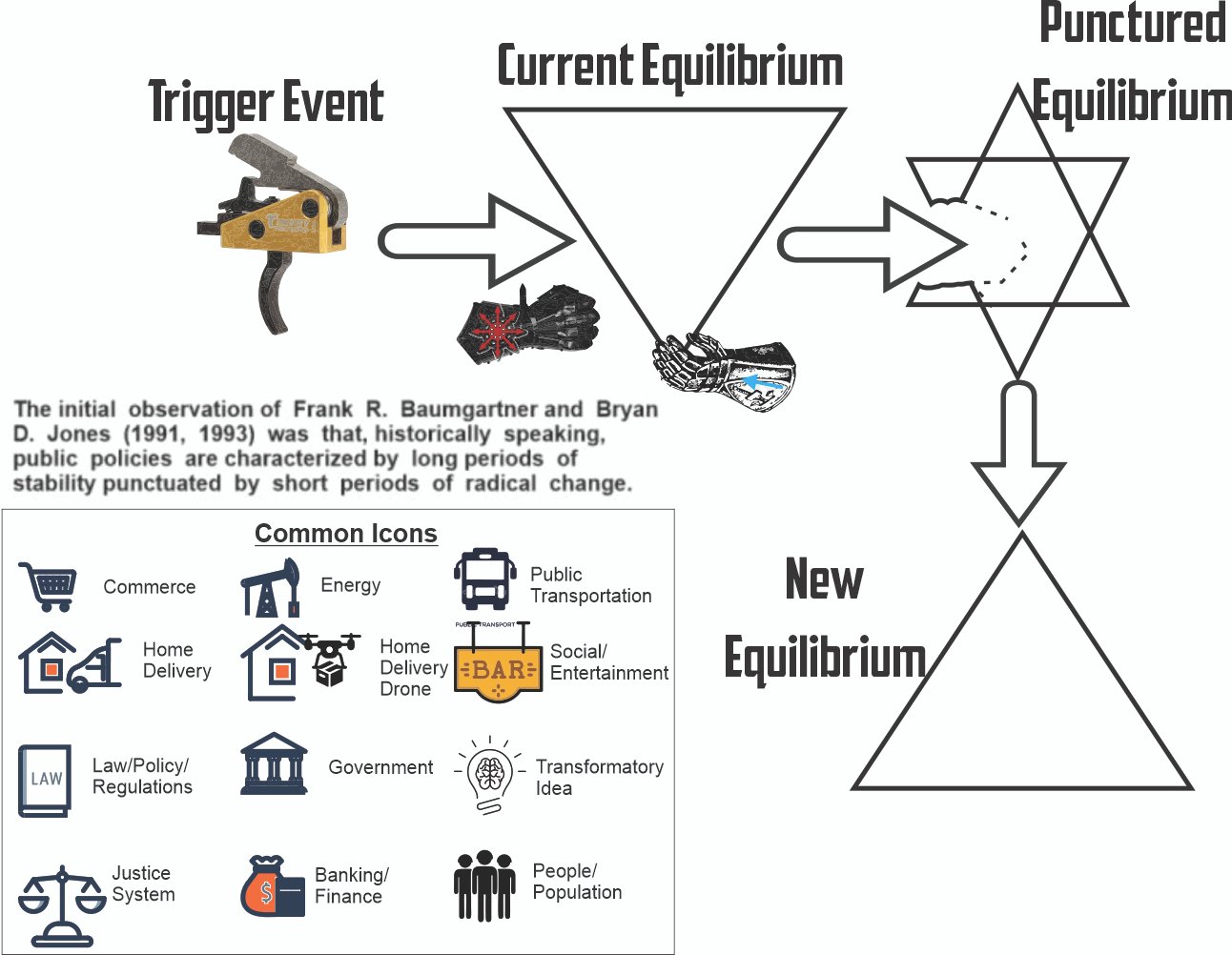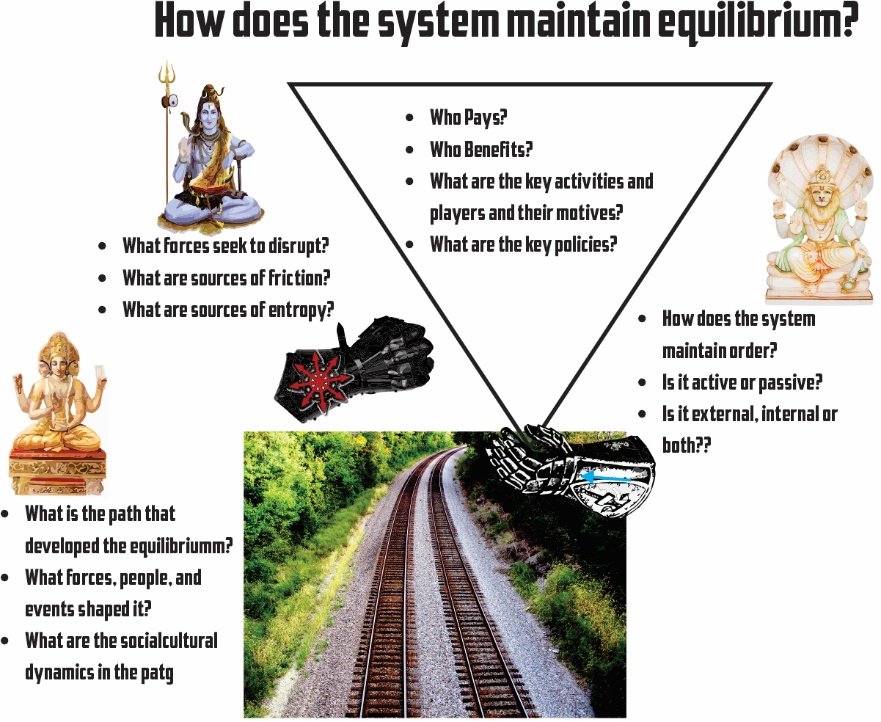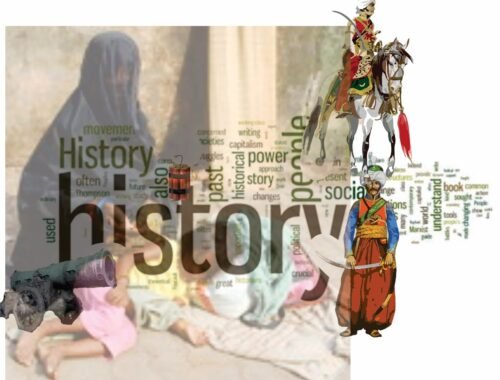
Part 2: The Conceptual Framework
Equilibriums are interesting. They seem to fly in the face of the Second Law of thermodynamics, which states that systems move from a state of order to a state of chaos. This process is called entropy. But the word equilibrium contains the key. Equilibrium involves a balancing of forces. If entropy is constantly driving systems and situations to chaos, other forces must counteract the chaos to maintain an equilibrium. If an actor wants to move to a new state of equilibrium, he or she must add force to not only counteract the forces maintaining the current equilibrium but also to force it to a new state and maintain it there.

Figure The Hindu Trimurti: Brahma, Vishnu, and Shiva
Mythology can often provide a useful guide or set of symbols to help illustrate and understand key concepts. The Hindu Trimurti, shown in Figure 1, illustrates the 2nd Law of thermodynamics and equilibrium dynamics. Brahma, the top image, is the Creator. Vishnu, the lower left image, is the Preserver. Shiva, the lower right image, is the destroyer. The 2nd law states that systems will move from order to chaos through entropy. Brahma is the force that creates the system. Shiva is the entropic forces that seeks to move it from order to chaos. Vishnu is the for that preserves order and counteracts entropy. In the conceptual framework in Figure 2, the black, mailed fist represents the entropic forces, and the silver open hand represents the preserving forces. The red 8 arrowed image is the traditional symbol of chaos. The blue straight arrow is the traditional symbol for order.
Conceptual Framework
The Pathbreaking Strategy Conceptual Framework in Figure 2 builds on the theory and concepts developed in Part 1. It uses the path dependency and punctuated equilibrium theories. The framework helps historians to analyze historical events, analysts to understand current situations and develop policies and responses, and planners to develop game changing strategies.
Current Equilibrium
The current equilibrium triangle represents the path dependent current state. As discussed in the theory section of Part 1, the situation, organization, or policy remains in this state because favorable past outcomes create a normalcy that is hard to break. The black, mailed fist represents the entropic forces that seek to break the equilibrium and the silver open palm represents the forces required to maintain the equilibrium. In the path dependent equilibrium, these forces are in balance and organizations and institutions may not even be aware of the energy and resources they spend to maintain the equilibrium.

Trigger Event
The trigger event(s) is/are the exogenous—external—forces or events that create the punctuated equilibrium. These forces differ from the system entropic forces. They could be events that inhibit the preserving forces that counteract the entropic forces or external events in the environment. They can also be internal actions that create new dynamics in the external environment. The Uber illustration is Part 3 is an example. These create exogenous events that can cause punctuated equilibriums in markets, organizations, government, finance, and institutions. With Uber, the punctuated equilibrium affected them.
Icons
The icons placed in the current equilibrium triangle show the activities, institutions, policies, processes, and social norms/issues the punctuated equilibrium will affect. The box in the lower left corner contains common icons, but analysts and planners can add others as needed. For example, the Uber case has a taxi icon and an Uber car icon.
New Equilibrium
The new equilibrium is a punctured six-pointed star. The shape reflects the impact of the trigger event on the current equilibrium. Analysts and planners place the icons used in the current equilibrium in this, but can color them, tilt them, or cut holes in them to show the severity of the trigger event. For example, in the WWI illustration in Part 3, cutouts on the people icon show the enormous loss of life in the war and changes to society.
The new equilibrium triangle shows the structure of the post punctured equilibrium environment. It may contain additional or different icons to show the new structure. Analysts and planners colored and resize the original icons to show the new state and emphasize the changes. For example, the generic illustration in Part 1 changes the home delivery icon to use a drone rather than a truck.
A new equilibrium can morph into a punctuated equilibrium. The WWI case in Part 3 shows this. The peace settlement in WWI created an unstable situation that led to WWII. The follow on British and French League of Nation mandates to occupy Arab former parts of the Ottoman Empire helped eventually to radicalize Islam. While many forgot WWI in the horrors of WWII, it affects continue to linger and drive current events. There are many facets in the legacy of WWI.
Using the Conceptual Framework
Perhaps the history quote from Santayana needs some revision. Rather than repeating history, those that do not understand it are doomed to perpetuate problems and exacerbate them.
If path dependency is correct, and research does support it, history is more than just an academic subject. It is vitally important to develop effective policy and strategy. Analysts and planners need to understand the historical background of any situation they want to change. That understanding must multi-faceted and analysts and planners must understand not only the individual facets, but also how they fit together and influence each other.
Now, not every decision or plan requires this deep understanding of history. But the game changing decisions and plans certainly do, even if the history is narrowly focused. Given their effects and the way they affect people, most government policy needs to understand the background of the situation they seek to change. Even a narrowly scoped history may have several facets and nuances that analysts and planners need to understand.
It takes a team to understand a complex equilibrium. The team may need to include historians, functional analysts, data scientists, and planners, depending on the intent, scope, and complexity of the project.
Cognitive biases and unfamiliarity may blind analysts and planners to the important nuances of facets. The more faceted and complex the situation, the greater the need for cognitive diversity and perspectives in an analytical and planning team. Team members need to check their biases and agendas at the door. That is easy to say and hard to do. The team needs to answer the questions in Figure 3 to understand the situation and what, if anything, to do about it. Determining which icons to use, how to place them, and what happens to them helps to focus the process and may show some cognitive biases.

Figure Key Questions to Understand the Path Dependent Equilibrium
Historians
Their task is to develop a clear understanding of the path that generated the equilibrium. Leaders rarely include historians in an analytical and planning team. Most organizations do not need them for normal organization operations and functions, but can be invaluable in complex analysis. But since most organizations do not have a staff of historians, or even a historical advisor, this area is often overlooked and rarely used. Even the Army, which has historians, rarely uses them for operational purposes. The closest the Army has come are the Human Terrain Teams, which included social scientists. Savvy organizations may consider establishing a relationship with the history departments at universities for on demand expertise.
Functional Analysts
Leaders need to tailor the analytical team to the dynamics of the situation. Depending on the complexity, they may need to develop an initial analytical team and then add to it based on the historical analysis. This team needs to understand what threatens and what supports the current equilibrium. What needs to change in order to break the path dependency? Are there any exogenous forces that may trigger a punctuated equilibrium? If there are no current forces, what events could trigger a punctuated equilibrium and where and might they arise?
Data Scientists
If the data is complex, the team may need data scientists to wrangle the data and develop information for the historians, functional analysts, and planners. Functional and historical experts need to work closely with the data scientists to find the right data, develop effective data structures and queries and reports that answer the critical questions found in Figure 3.
Planners
Once the team understands the dynamics of the current path dependency and equilibrium, they need to determine whether to continue to maintain it, examine ways to change it, or move away from it altogether. This can be organizational strategy or key policy. The information from the analysts, provide the constraints and other factors the planners will use in their normal planning process. If the situation is very complex, they may want to use scenario planning and simulations to find an optimal solution and to test its effects. They should pay attention to the icons in each stage and ensure they capture the path/equilibrium, and the effects of the punctured equilibrium.
Small problems
Organizations can use the approach for small problems. The primary difference is the team may be small or perhaps even a single person. For example, a team leader may use the approach to change a key process. The leader needs to understand the current process and why it was designed and implemented. While a historian is not required, the history of the process is important, and the leader must understand it. Likewise, the leader needs to understand the functions, people, resources, inputs, and outputs from the current process. These are the same questions in Figure 3, just on a smaller scale.
Part 3 illustrates the process with three case studies.




